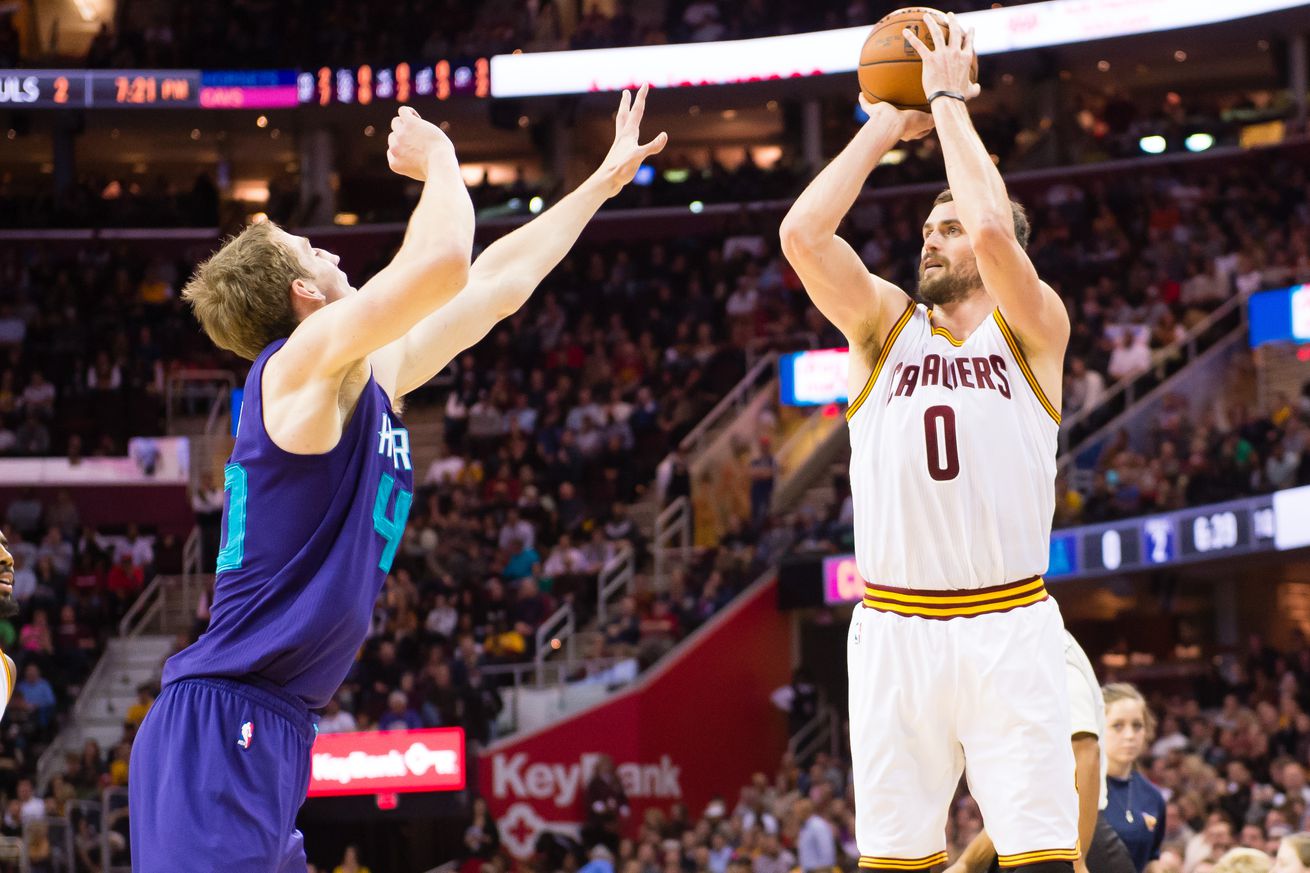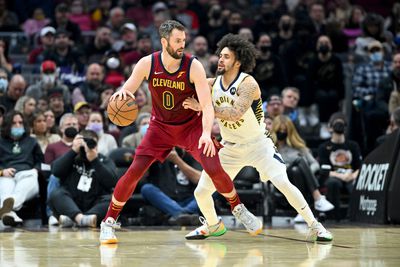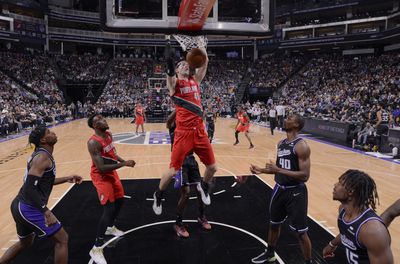
Let’s dive into some film!
Moves! The Miami Heat made moves!
It was reported the Sunday that the Heat would be adding to their frontcourt, planning to sign Kevin Love and Cody Zeller on Monday to fill their final two roster spots. Let’s hit the film room and examine how they fit with the roster in-place!

Photo by Jason Miller/Getty Images
Kevin Love
F/C | 6’8” | 250 lbs. | Age: 34
2022-23 stats (41 games): 8.5 PPG | 6.8 RPG | 1.9 APG | 38.9 FG% | 35.4 3P% | 55.5 TS% | 13.7 PER
Love played 41 games for the Cleveland Cavaliers before getting bought out. By the end of his Cleveland tenure, he was practically out of the Cavs rotation — slotted behind Dean Wade and Cedi Osman, in addition to Evan Mobley and Jarrett Allen, obviously. He racked up nine consecutive DNP-CD’s before the All-Star break and only has started seven of his 115 games over the last two seasons.
Love, by his standards, is having the worst year of his career — only averaging 8.5 points and 6.8 rebounds, both career lows, albeit in 20.0 minutes per game. He is expected to have a bigger role in the Heat rotation once he becomes acclimated, so let’s dive into his fit!
Floor Spacing:
Right away, arguably the most eye-popping trait that Love provides is his floor spacing.
I’d be remiss to mention that Love fractured his right thumb in late November and has canned just 31.9 percent of his 4.3 triples since Dec. 12 — when he returned to the rotation full-time. He hasn’t played in nearly a month, so one could assume he’s gotten more time for the injury to heal and better itself, even if it’s still not 100 percent.
Nevertheless, he offers the threat of a floor spacer that Miami hasn’t had since Kelly Olynyk, who was traded in March of 2021 for Victor Oladipo. At this point, any semblance of new shooting helps. Love may not fix everything — heck, he may not fix anything — but he’s certainly worth the flyer.
Miami sports the third-worst 3-point efficiency leaguewide (33.4 percent) with the NBA’s lowest catch-and-shoot 3-point percentage at 33.3 percent. Not great, Bob!
There’s evidence to suggest that Caleb Martin can shoot 40+ percent from deep over a considerable stretch of games when he’s healthy, but teams haven’t respected him — nor Haywood Highsmith (35.7 3P%, 2.3 attempts) — from beyond the arc this season, even as two of their most efficient 3-point shooters.
That’s in-part because of the threats Bam Adebayo and Jimmy Butler possess within ~15 of the basket, and an indictment on the spacing — or lack thereof — elsewhere. Though teams will respect Love more than cohorts, and his ability to be a pick-and-pop threat isn’t something Miami’s had next to Adebayo since Olynyk.
His pop ability especially helps Miami’s primary-and-secondary ballhandlers — notably Jimmy Butler, Tyler Herro, Oladipo, Gabe Vincent and Kyle Lowry — especially if they draw two.
Not all of them carry the exact on-ball threat of Donovan Mitchell or Darius Garland when attempting to turn the corner, but there’s situations where Herro and Butler gets blitzed or hedged above-the-break, so they’re not able to turn said corner.
Love’s the perfect outlet; his ability to 1.) open himself up in the open gap for the pocket pass or 2.) ghosting the action, freeing himself creates an extra perimeter valve for a Heat offense that chucks plenty of triples is important. It’s extra movement to potentially open up additional gaps for Butler, Herro, Oladipo and others to utilize. Plus, Love is a good enough playmaker and connector (see below) to swing the rock around if tag defenders pre-emptively rotate to Love.
His floor-spacing is crucial in more ways than one, especially since it’s complimentary of Adebayo’s skillset.
Playmaking:
It’s easy to look at the raw counting numbers and not be appeased by Love’s playmaking.
But he shows legitimately good playmaking chops that can help this Heat offense, especially in the mid-to-high post.
Miami’s ran sets with Bam Adebayo or Jimmy Butler planted at the mid-to-high post with plenty of off-ball activity — be it back-screens, normal/stagger pin-downs or cutters finding an open alley — elsewhere, typically acting as a pre-cursor to its dribble hand-off actions.
It’s something they also ran with P.J. Tucker last year — who was also one of their primary hand-off hubs.
These exact actions fit perfectly into Love’s arsenal since it’s something he did often in Cleveland.
Love, at 6-foot-8, is incredibly adept and precise at locating cutters in the post. He has enough height to see over smaller defenders to locate cutters or open perimeter threats.
Love’s passes over either shoulder are very well-timed and accurate; he’s very precise with his passing touch and the location of said pass — whether it’s to a stand-still spot-up threat or a cutter — showcasing the ability to fling a cross-court dime, lob a touch pass over multiple defenders or bounce the rock to an impending cutter.
Strus, Butler and Martin — three of the Heat’s most boastful cutters — will specifically benefit from Love’s playmaking, as well as when all three (and others) are spot-up threats rolling around hand-offs or flying off weak-side actions.
In addition to his playmaking in the post, it’s worth mentioning that Love is a very good connective passer — arguably the best of any buyout player, and frankly, sneakily one of the best among other forwards leaguewide.
Love’s lost a little juice as a post player in general, but all of this combined accentuates any offense.
Oh, and let’s not forget about how special his hit-ahead passes are, either.
— Matt Hanifan (@mph_824_) February 18, 2023

Photo by Rocky Widner/NBAE via Getty Images
Cody Zeller
C | 6’11” | 240 lbs. | Age: 30
2021-22 stats (41 games): 5.2 PPG | 4.6 RPG (1.9 ORB) | 56.7 FG% | 62.7 TS% | 17.2 PER
O.K. enough about Love. Let’s talk about Miami’s other acquisition: Cody Zeller!
The Zeller acquisition feels eerily similar to when Miami acquired Dewayne Dedmon at the end of the 2020-21 season, when they were also in desperate need of a backup big. Neither Dedmon nor Zeller were on any respective teams before they signed.
Dedmon was waived-and-stretched ahead of the season after getting traded to the Detroit Pistons. Zeller, meanwhile, suffered a patellar fracture, that limited him to 27 games with the Portland Trail Blazers last season. Zeller ended up being a roster-size casualty from the Utah Jazz ahead of the season, prioritizing Walker Kessler and Udoka Azubuike instead.
Now, Zeller is expected to be the primary backup big behind Adebayo for the foreseeable future. Let’s dive into his fit!
Rim-Running/Roll Threat/Screener:
All of these play hand-in-hand.
Zeller’s not a natural floor-spacer, so Spoelstra might initially give him a very simple roll (pun intended): Just run to the rim big fella!
It’s not something he hasn’t done before, either — especially when he was involved in Portland’s steady dose of high pick-and-roll with Damian Lillard and Anfernee Simons.
Over his last seven seasons, Zeller’s ranked in the 80th percentile or greater in rim frequency, reaching the 85th percentile in three of those seasons, per Cleaning The Glass. He’s not particularly a great finisher, placing below the 50th percentile in rim efficiency in all but one of those seasons, but Zeller’s certainly going to dive to the rim with a head of steam, especially after freeing up a player with a sturdy screen.
He’s an active screener, too!
Since the NBA really started tracking screen assists in 2016-17, in the four seasons he’s logged at least 1,000 total minutes, he’s ranked in the top-30 in screen assists per 36 minutes, including leading the league in 2016-17 and 2018-19 with 7.6 screen assists per 36. He even ranked second in screen assists per 36 with 7.7 up until his injury in early December last season (min. 250 minutes).
From Zeller in Dec. of 2016, via Bleacher Report:
“In college, I could score just off my athletic ability, but in the NBA, everyone is the same as me, if not more athletic,” Zeller said. “So I had to figure out different ways to score.
“It’s all about getting the right angle,” he said. “So you want to try set the screen on the lower half of the defender’s body, like this.” He shifted, placing his toes at a 45-degree angle and his left shoulder, on the outside half of his body, pointing towards the left corner of the court.
“A lot of guys want to get under, especially when Kemba wasn’t shooting well a couple of years ago,” Zeller said. “So that was always a big emphasis.
“I’ll turn around and flip it around—we call it ‘twist’,” he said. “You just flip it around. There I’m one step lower and closer to the basket. They can’t go under.”
Read the full story of Zeller’s screening and more here.
Zeller’s offensive skillset will likely be utilized in multiple different facets (see more below), but his screening and ability to generate some rolling gravity could pay dividends for a Heat offense that has hasn’t had the most success bending defenses this season, relative to previous seasons.
Kelly Cody Keepers?:
If you’ve been following Heat basketball for a reasonable amount of time, you’ll probably know exactly what I’m talking about when I refer to the infamous “Kelly Keepers,” in reference to Kelly Olynyk’s fake DHOs.
Olynyk, who was good at pump-faking and attacking closeouts on the perimeter during his tenure in Miami, occasionally pulled the #KellyKeepers™ out of the bag to out-leverage opponents when heading downhill. He didn’t pull it out often, but when he did, it was effective.
Zeller’s got a similar bag to him; if he has the ball on the perimeter, he’s typically looking to set up a DHO or connect a pass before screening on- or off-the-ball. But Zeller’s not prone to ripping out keepers of his own.
Similarly to Olynyk, Zeller’s not going to wow anyone with his athleticism. Though he’s mobile and smart enough to know the perfect opportunities to attack and convert off-the-bounce in hand-off situations.
(Short) Roll Playmaking:
Comparably to Love, Zeller’s playmaking numbers aren’t exactly representative of what he’ll flash. When he was in Charlotte, he was used heavily as hand-off threat in the high-post; he’s similar to Love with regards to how he can make plenty of high-level passes, even though he’s not as wholly skilled as a passer. but what stood out the most to me over the last couple of seasons was his short-roll playmaking.
Zeller was oftentimes a quick decision-maker in the short-roll on deciding when he would attack, or kick-out to an open shooter. He’s got good pacing and positioning when he rolls, never playing himself out of a pass or getting buried too deep in the action. That offers him a sliver of space to take a dribble or two before kicking out (if needed).
Miami hasn’t possessed a consistently good playmaking big behind Adebayo since Olynyk. They drafted Nikola Jovic — who’s an advanced playmaker at 6-foot-11 — but he’s still developing and hasn’t really cracked the rotation yet; Yurtseven and Orlando Robinson have showed flashes; Precious Achiuwa was a capable playmaker, but was limited in his role as a rookie before he got shipped to Toronto.
Zeller’s not at the level of Adebayo, or even Love, but he’s a capable enough playmaker to run **some** actions (DHOs, split cuts, Chicago) off him with the rock in his hands, especially in the pick-and-roll off Herro, Butler, Vincent, Oladipo and Lowry, among others.
Offensive rebounding:
Last, but certainly not least, it’s imperative to discuss Zeller’s offensive rebounding ability.
Zeller is a very good offensive rebounder; since the start of the 2019-20 season, he’s averaged 4.4 offensive rebounds per 36 minutes with a 12.9 offensive rebounding percentage, the 15th-highest in the Association (min. 2500 minutes).
Despite averaging only 20.3 minutes over that span, he’s grabbed at least four offensive boards in a single game 39 times — nearly one-third of his games — with three in 24 more of those games.
That’s where being a rim-runner plus a playmaker in the short-roll is vital — he’s already in position to clean up misses regardless if they’re from him or another teammate. And he certainly possesses the motor and positioning to capitalize on those opportunities when they’re presented to him.
What about their defense?
Neither Zeller nor Love are good defenders, per say. But neither have Miami’s other backup bigs over the last several years. The last good-to-great overall defender Miami had coming off the bench was … well, Adebayo, when he backed up Whiteside. This obstacle isn’t new.
Miami’s likely going to play (deep) drop with both Love or Zeller, like they have with Dedmon/Yurtseven/Olynyk/Meyers Leonard while switching (most of) the rest.
In theory, when healthy, Miami will have a combination of Vincent, Butler, Oladipo, Highsmith and Martin on the floor at all times to make up for any shortcomings from Love or Zeller. In any scenario, Miami — who’s practically turned into #SyracuseSoutheast™ when dialing up the zone in lineups with one of or both Adebayo and Butler off the floor — can mask any deficiencies with Love or Zeller in zone.
The Heat, a top-5 defense, have dealt with worse on the back-line, though both are nothing to ride home about, either.
What’s the rotation look like?
**My current projection for a hypothetical 12-man rotation, assuming everyone’s healthy.**
***I’m most likely wrong, because 1.) anything can happen and 2.) I’m wrong, a lot.***
Starters:
- Gabe Vincent
- Tyler Herro
- Jimmy Butler
- Kevin Love
- Bam Adebayo
—————————————————
Bench:
(Bench is listed in no order)
- Victor Oladipo
- Max Strus
- Cody Zeller
- Kyle Lowry
- Caleb Martin
- Haywood Highsmith
- Duncan Robinson
Let’s rock!